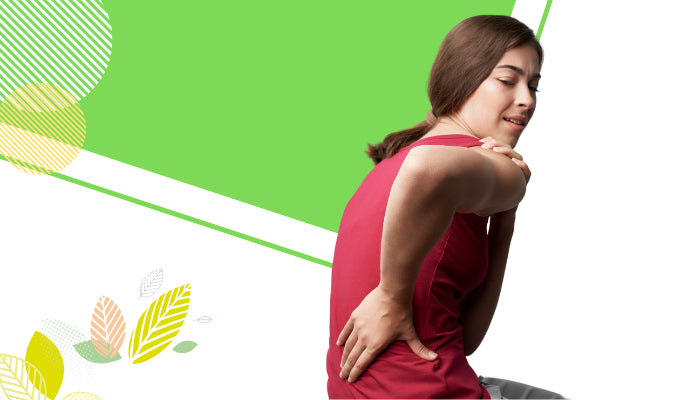Your Cart is Empty

জয়েন্ট মানে যেখানে দুই বা ততোধিক হাড় মিলিত হয়। এটি কঙ্কালের সংযোগ বিন্দু। জয়েন্টগুলির মধ্যে রয়েছে - কাঁধ, হাঁটু, মেরুদণ্ড, নিতম্ব, কনুই ইত্যাদি। বয়স, অতিরিক্ত ব্যবহার বা পূর্বের আঘাতের কারণে এই দাগগুলি ব্যথা, শক্ত, অস্বস্তি বা প্রদাহ অনুভব করতে পারে।
জয়েন্টে ব্যথা খুব বিরক্তিকর হতে পারে! এই ব্লগে, আমরা জয়েন্টে ব্যথার কারণ, চিকিত্সা এবং প্রতিরোধ নিয়ে আলোচনা করব যাতে আপনি আপনার জয়েন্টগুলিকে শক্তিশালী রাখতে এবং একটি ভাল এবং স্বাস্থ্যকর জীবনযাপন করতে পারেন!
তাই পড়তে থাকুন এবং খুঁজে বের করুন!
জয়েন্টে ব্যথার পেছনে অনেক কারণ থাকতে পারে। বেশিরভাগ জয়েন্টে ব্যথা আর্থ্রাইটিসের দিকে পরিচালিত করে, তবে অন্যান্য কারণও রয়েছে।
চলুন জেনে নেওয়া যাক জয়েন্ট শক্ত হওয়ার পেছনের সাধারণ কারণগুলো-
আর্থ্রাইটিস মানে এক বা একাধিক জয়েন্টের প্রদাহ বা ফুলে যাওয়া। এটি 100 টিরও বেশি অবস্থার বর্ণনা করে যা জয়েন্ট, জয়েন্টের চারপাশের টিস্যু এবং অন্যান্য সংযোগকারী টিস্যুকে প্রভাবিত করে। আর্থ্রাইটিসের প্রকারের উপর নির্ভর করে নির্দিষ্ট লক্ষণগুলি পরিবর্তিত হয় তবে সাধারণত জয়েন্টে ব্যথা এবং শক্ত হওয়া অন্তর্ভুক্ত থাকে।
ফাইব্রোমায়ালজিয়া : ফাইব্রোমায়ালজিয়া একটি দীর্ঘস্থায়ী (দীর্ঘস্থায়ী) ব্যাধি যা সারা শরীর জুড়ে ব্যথা এবং কোমলতা, সেইসাথে ক্লান্তি এবং ঘুমের সমস্যা সৃষ্টি করে।
স্ক্লেরোডার্মা : স্ক্লেরোডার্মা একটি দীর্ঘস্থায়ী, যদিও বিরল, অটোইমিউন রোগ যেখানে স্বাভাবিক টিস্যু ঘন, পুরু তন্তুযুক্ত টিস্যু দিয়ে প্রতিস্থাপিত হয়। স্ক্লেরোডার্মা রোগীদের মধ্যে, ইমিউন সিস্টেম অন্যান্য কোষকে অত্যধিক কোলাজেন (একটি প্রোটিন) তৈরি করতে ট্রিগার করে। এই অতিরিক্ত কোলাজেন ত্বক এবং অঙ্গগুলিতে জমা হয়, যা শক্ত এবং ঘন হয়ে যায় (দাগ দেওয়ার প্রক্রিয়ার মতো)।
প্রতিটি জয়েন্টে একটি তরল-ভরা পাতলা থলি থাকে যা বারসা নামে পরিচিত। এটি নড়াচড়ার সময় ঘর্ষণ কমাতে এবং হাড় এবং টেন্ডনগুলিকে কুশন করতে সহায়তা করে। যাইহোক, এই bursa স্ফীত হতে পারে এবং bursitis নামে পরিচিত জয়েন্টগুলোতে গুরুতর ব্যথা হতে পারে।
বারসাইটিস বেশিরভাগ কাঁধ, নিতম্ব এবং কনুইতে দেখা যায়। আপনি আপনার হাঁটু, গোড়ালি বা বুড়ো আঙুলেও ব্যথার সম্মুখীন হতে পারেন। এই অবস্থাটি বেশিরভাগ নির্দিষ্ট জয়েন্টগুলির পুনরাবৃত্তিমূলক আন্দোলনের জন্য ঘটে।
যখন একটি জয়েন্টের চারপাশের ক্ষতগুলিকে চাপ দেওয়া হয়, তখন এটি ব্যথা সৃষ্টি করতে পারে। এটি প্রায়শই ঘটে যখন আপনি কিছু বিস্তৃত হাঁটু গেড়ে বসেন বা আপনার মাথার উপরে কিছু তোলেন।
টেন্ডিনাইটিস হল টেন্ডনের প্রদাহ। এগুলি হল ফাইবারস কর্ড যা হাড়ের সাথে পেশী সংযুক্ত করে।
সাধারণত আঘাত বা পুনরাবৃত্তিমূলক আন্দোলনের জন্য, জয়েন্টের টেন্ডন প্রভাবিত হতে পারে এবং ব্যথা এবং শক্ত হয়ে যেতে পারে।
Tendinitis বিশ্রাম এবং যত্ন সঙ্গে চিকিত্সা করা যেতে পারে. কিন্তু দীর্ঘস্থায়ী প্রদাহ টেন্ডন ছিঁড়ে যেতে পারে এবং এর জন্য অস্ত্রোপচারের প্রয়োজন হতে পারে।
লিগামেন্ট ইনজুরি
লিগামেন্ট একটি হাড়কে অন্য হাড়ের সাথে সংযুক্ত করে। তাই দুর্ঘটনার জন্য, আপনার লিগামেন্টে আঘাত হতে পারে এবং এটি প্রচুর ব্যথা হতে পারে।
অন্যান্য কারণ অন্তর্ভুক্ত হতে পারে-
এখানে কিছু উপায় রয়েছে যা জয়েন্টের ব্যথা নিরাময়ে সাহায্য করতে পারে:
আপনার জয়েন্টগুলির যত্ন নেওয়া অত্যাবশ্যক, বিশেষ করে যদি আপনি বৃদ্ধ হন। জয়েন্টের ব্যথা থেকে মুক্ত একটি সুস্থ শরীর অবশ্যই আপনার জীবনকে সহজ করে তুলবে!
উত্তর: হ্যাঁ, জয়েন্টের ব্যথা উপশমে ভিটামিন ডি খুবই উপকারী। ভিটামিন ডি-এর অ্যান্টি-ইনফ্লেমেটরি বৈশিষ্ট্য জয়েন্টগুলির শক্ততা এবং প্রদাহ কমাতে সাহায্য করে। তাছাড়া, গ্লুকোসামিন এবং কনড্রয়েটিনও সহায়ক হতে পারে।
উত্তর: অতিরিক্ত পরিমাণে আয়রন জয়েন্টে ব্যথা এবং ক্লান্তির কারণ হতে পারে। কারণ এই অতিরিক্ত আয়রন শরীরের বিভিন্ন জায়গায় জমে, টিস্যু এবং অঙ্গগুলির ক্ষতি করে এবং অস্বাভাবিক কষ্টের সৃষ্টি করে।
উত্তর: জয়েন্টগুলোতে বরফ লাগালে দ্রুত সুস্থ হয়ে উঠতে পারে। বরফের ব্যাগ ব্যবহার করুন বা একটি কাপড়ে বরফের টুকরো রাখুন এবং প্রায় 15 মিনিটের জন্য ফোলা জয়েন্টে লাগান। ব্যথা কম না হওয়া পর্যন্ত জয়েন্টটিকে সঠিকভাবে বিশ্রাম দিতে ভুলবেন না।
পরবর্তী পড়ুন: আমি কিভাবে আমার জয়েন্টগুলোতে প্রদাহ বিপরীত করতে পারি? টিপস এবং কৌশল
তথ্যসূত্র:
জয়েন্টে ব্যথা: লক্ষণ, কারণ এবং চিকিৎসা (clevelandclinic.org)
জয়েন্টে ব্যথা: কারণ, ঘরোয়া প্রতিকার এবং জটিলতা (healthline.com)
মন্তব্য দেখানোর আগে অনুমোদিত হবে.